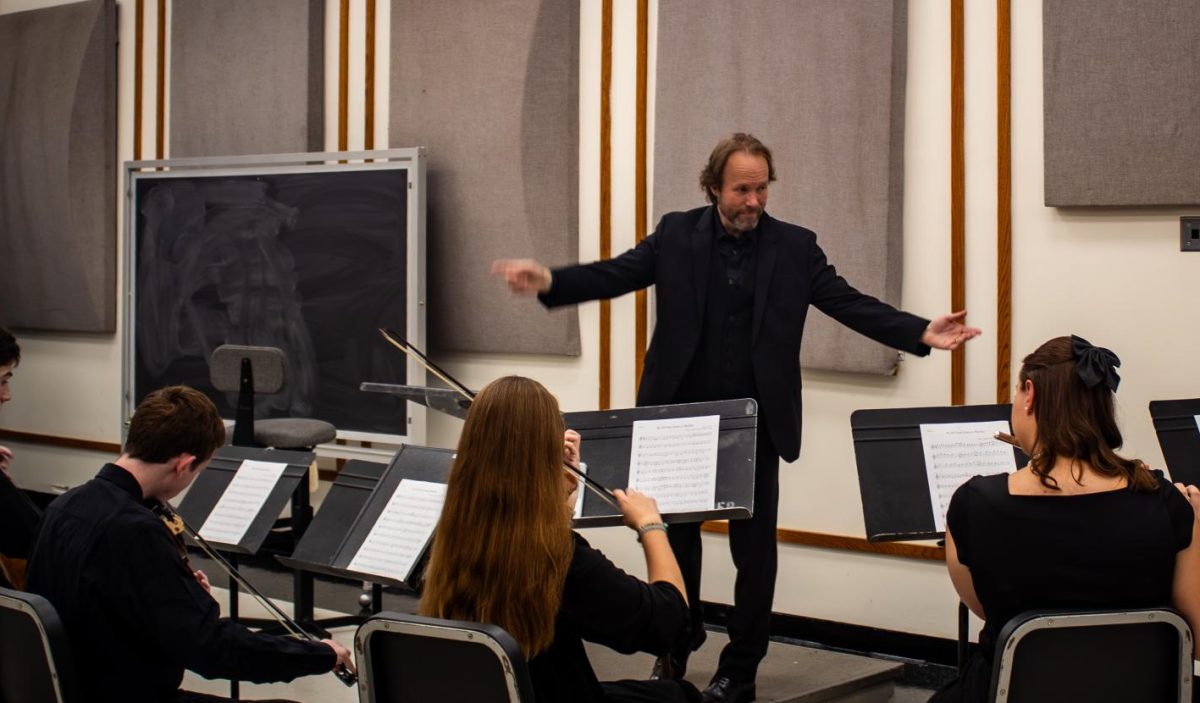Unwrapping the essence of Christmas music in CUC’s ‘Lessons and Carols’
Dr. Charles Brown leads the Kapelle in a rehearsal practice.
December 3, 2022
Rocking around the Christmas tree and sleigh bells ringing are the hallmarks of the holiday celebration. After all, Santa Claus is coming to town, and so is “Lessons and Carols,” the annual Christmas music performance at Concordia University Chicago.
The Kapelle, Männerchor, Schola Cantorum, Chamber Orchestra, and Handbell Ensemble usher in the holiday season with one of the most cherished CUC traditions on Dec. 3 and 4.
Christmas music is one of the most distinctive forms of celebrating the holiday season. After all, there’s no genre of music dedicated to Easter or Thanksgiving. When most people think of Christmas songs, they think of classic crooners like Bing Cosby or Burl Ives, smash hits like “All I Want For Christmas Is You” by Mariah Carey, “Please Come Home For Christmas” by the Eagles, or Michael Buble’s chart-topping album “Christmas.”
Although senior Jesse Schultz loves songs like “Joy to the World” and Christmas radio hits, the member of Kapelle says the music you hear in church and at “Lessons and Carols” points to storytelling rather than holiday traditions. “Songs on the radio tend to focus on secular Christmas elements like Santa, reindeer, cookies, mistletoe, and gifts — all not inherently wrong, but definitely serving a different purpose,” said Schultz. “Christmas music in a church service ultimately points its listeners to the magnificent Nativity event that took place in a lowly manger many years ago.”
The service held in the Chapel of the Lord at CUC features the story of Christ coming to Earth and His birth through nine lessons (referred to as carols).
The nine lessons in the performance came from Oxford, England in the 19th century. With a growing worry that people elected to go to the pubs instead of church, the musical component of worship provided a reason for people to return to church.
Charles Brown, DMA, is entering his 23rd year of directing the CUC choirs in “Lessons and Carols.” For him, it’s more than just a holiday concert. “Those nine lessons talk about the fall of humanity to the redemption that Christ gives,” said Brown. “Every lesson goes from Old Testament to New Testament. You basically trace Christ’s narrative from prophecy to fulfillment. And that’s a beautiful thing.”
The history of Christmas carols dates back to Martin Luther and the Protestant Reformation. Chorals came from the teachings of the time, and were closely related to carols. The English later translated the carols from German, to develop their own musical pieces.
Brown says Michael Praetorius and Johann Pachelbel were two composers who celebrated Christmas and carols unlike anyone else during the 17th century. “They really livened it up all around church,” Brown said. “They would have the readings and music, and it provided a lot of opportunities for response to that.”

“Lessons and Carols” tries to do the same for those in the audience, while remaining authentic and in-line with traditional practices. This means making slight changes to the music selection. Brown is excited for the audience to hear his arrangement of “A Boy Was Born” by Benjamin Britten. “It’s kind of simple, but it talks about God takes on flesh, bares our humanity, and why Jesus came to go to the cross,” Brown said.
Brown draws inspiration from Martin Luther for the reason for including this piece. “Luther said that if we fail to remember that’s what Christmas is about, then we have missed the meaning of Christmas,” said Brown.
Members of the Kappelle express that same desire to convey Luther’s message. “It is incredibly evocative and warm, causing listeners to ponder the marvel of Christ’s humble incarnation,” said senior Schultz.
Issac Conrad, a junior in the Kapelle and Schola Cantorum, says he feels the emphasis on breathing technique that he learned from Brown is what makes the songs resonate through the chapel. “When you can reflect that in a piece when the music ebbs and flows as if you’re not singing when you breathe out, but also when you breathe in, we really capture that in the piece,” said Conrad.
Brown attributes the popularity of Christmas music on the radio verse church music is the familiarity. “We associate Chirstmas with that warm feeling,” said Brown. “When you hear Faith Hill’s “Where are you Christmas?” and this warm invite to Jesus and Christmas, but the whole point is forgiveness and mercy as a result of that.”

For “Lessons and Carols,” the storytelling is more than just songs and musical arrangements. Brown says the environment within the chapel helps complement and enhance the service. “The design starts very dark, since the world was dark,” said Brown. “We gradually bring the lights up, so by the holy birth reading, the chapel is full of light.” From there, the lighting gradually dims again through the finale of “Noel, Noel,” and attendees leave the performance in the dark.
Sophomore Matthew Clayton says being in Kapelle and the Chamber Orchestra allows him to experience the service in a unique way. “Singing is all about the text, and you can sing the message and see the text,” said Clayton. “In music, it’s harder, you’re still reading a language and communicating it.”
Brown realizes Christmas time and holiday services may be one of the rare times people may sing along with performers, since the songs are familiar. “We think it’s important for people to participate, or at least you’re invited to participate whether that’s sing and pray, or just to listen.”
Lessons and Carols will host three performances in the Chapel of the Lord. On Saturday, Dec. 3, performances will be 4 p.m. and 7 p.m. The Sunday, Dec. 4, performance will begin at 4 p.m. A livestream of the service will follow at 6:40 p.m. at cuchicago.edu/live.

































